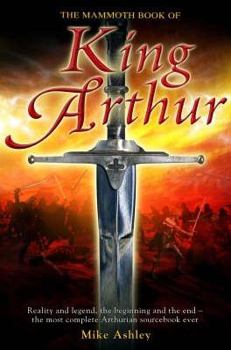The Mammoth Book of King Arthur. Mike Ashley
In this truly mammoth guide, Mike Ashley analyzes and explicates the line between the real Arthurian world and the legends that surround it. Ashley gives us a firm identity not only for King Arthur,... This description may be from another edition of this product.
Format:Paperback
Language:English
ISBN:184119249X
ISBN13:9781841192499
Release Date:January 2005
Publisher:Robinson Publishing
Length:670 Pages
Weight:1.08 lbs.
Related Subjects
Anthologies Arthurian Contemporary England Europe Fantasy Fiction Folklore & Mythology Genre Fiction HistoricalCustomer Reviews
2 ratings
Title says it all
Published by Thriftbooks.com User , 16 years ago
A perfect sourcebook for Arthurian lore, ranging from Welsh histories to modern movies and novels. Jammed packed with information, but certainly not boring to read. This book is awesome!
A Whole Lot Of Camelot
Published by Thriftbooks.com User , 18 years ago
I've had spotty luck with the Mammoth series before; some are quite decent, some are obvious hack jobs, and one or two are just loony (the Mammoth Book of Jack the Ripper pops to mind). This one is divided into three rough sections, of unequal size and value. The first attempts to break down the "historical Arthur," who Ashley defines first as "the war-leader of the Britons at Badon Hill" and only second as "the guy who Geoffrey of Monmouth was talking about." This results in a pretty thorough chase through obscure Breton king-lists, Nennius, the Ten Battles (fifty pages on them alone), the Welsh Triads, and so forth until he gets to a list of twenty, count-em, suspects. These range from Lucius Artorius Castus (the only Roman commander named 'Artorius' known to have served in Britain) to Arthwys ap Meurig (the king, perhaps, of Gwent in the seventh century, unless he wasn't). Ashley quietly plumps for an Arthur based in Gwent or Powys, but argues that Geoffrey's "Arthur" is a composite of five or six British leaders with mythic elements from Alfred and Aethelstan, and constructs a perhaps over-delicate genealogical lattice-work with which to argue that the victory at Badon was a coalition victory under a king of Dyfed named Agricola or Aircol, with one Vortipor/Gwerthefyr as the primary commander and possible "dux bellorum." This is about as good as things get without getting into Deep History. If this section has a flaw, it's probably best highlighted by Ashley's nervous-making habit of citing Laurence Gardner's Bloodline of the Holy Grail without using the words "barking mad." I'm certainly not an expert in post-Roman British chronicles, so for all I know, Gardner's research into the political-military complexities of the Saxon frontier is actually a model of meticulous restraint -- but I doubt it. Ashley does do a good job of highlighting when some fruity speculation is Gardner's and Gardner's alone -- the first time it appears. By contrast, he is politely dismissive of Geoffrey Ashe's various enthusiasms, and wisely so. That takes us to page 306, where we begin about 200 pages of primer on the Arthurian Cycle, beginning with some potted history of the twelfth century and then into the various versions of the Tristan, Lancelot, Perceval, Galahad, Merlin, and other sub-cycles through the 14th century. This is excellent stuff, well presented; the Grail section is remarkably free of utter crazitude, although again it's no substitute for a specialist work on the topic like Richard Barber's The Holy Grail (the best single book on the topic). Then a short chapter on Malory, and another brings us up to Tennyson and the Pre-Raphaelites. This is all clear and relatively straightforward; it's also stuff I probably could have assembled myself from my bookshelves -- but not in only $13.50 worth of my time. We close up with sixty pages of Arthurian novels, narrowly defined (no That Hideous Strength or Drawing of the Dark), and ten pages of Arthurian movi





